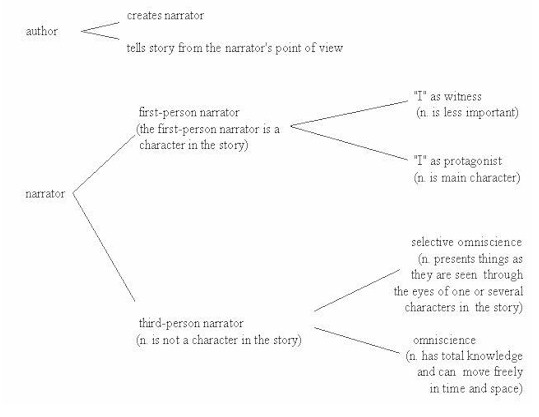

Point of view refers to the way a story is told. The author selects a specific mode of presenting the characters, action, setting and events of his or her narrative. The choice of the point of view or perspective normally entails the setting-up of a narrator as mediator between story and readers, as someone who guides the readers and influences them in their reception of the text.
The degree of insight or penetration the narrators have into the characters and events of a text varies, forming a graded line from telling - the narrators know everything and impart their knowledge to the readers as they think fit - to showing - the narrators are practically absent and the readers have to infer everything from the events as they unfold. The narrators may either speak in the first or third person without any basic change to their roles. A classification according to their degree of insight would, therefore, appear to be most useful and relevant.
The narrators know everything that has ever happened or will happen. They have a complete insight into all their characters, their motivations and feelings. They do not themselves participate in the story, but view from outside, supplying their comments and evaluations and even directly addressing the readers from their vantage points.
They are not obliged to adhere to the chronology of events, and can employ elements of flashback and anticipation to heighten the tension. They can also move freely among the different locations and events.
The narrators are the protagonists in the stories. They are restricted in their knowledge to what they can possibly know without violating the rules of probability. The function of narrating a story can also be split up between two or more characters in the text, who give different evaluations of the same events. This can also be achieved by means of letters and messages, for example.
| 1. The narrator | views stands back from the action and observes. remains outside the plot, merely observing. |
... from a distance. | |
| 2. His lack of involvement permits the narrator to maintain an analytical stance. | |||
| 3. The narrator describes the action and characters objectively. | |||
| 4. The story is narrated in the third person, and the narrator never surfaces. | |||
| 5. There is no interference by the narrator throughout the text. | |||
| 6. The narrator | is not involved explicitly. is a thinly-sketched character on the edge of the story. |
||
| 7. The narrator | plays a more active role in intervenes in pronounces judgment on |
the text. | |
| 8. The narrator | takes part in is involved in is one of cannot escape from |
... | |
| 9. The narrator is simultaneously a central character in the story. | |||
| 10. The story is told from the narrator's angle. | |||
| 11. The fact that the narrator is involved results in the narration being biased and slanted. | |||
| 12. The narrator's views are committed because of his/her participation in the plot. | |||
| 13. The narrator describes the event from the point of view of ... | |||
| 14. The narrator's attitude towards his/her material is ... | |||
| 15. The events are viewed from a subjective angle. | |||
| 16. The description is | restricted limited |
to ... | |
| 17. The narrator's relation to the text is confined to ... | |||
| 18. The narrator's views are as subjective as those of the others. | |||
| 19. The narrator | intends to wants to seeks to |
influence manipulate |
the reader. |
| 20. The narrator's introductory remarks also | include deal with refer to |
... | |
| 21. The points of view in the text shift from character to character. | |||
| 22. The intention of this narrative approach is ... | |||
![]()